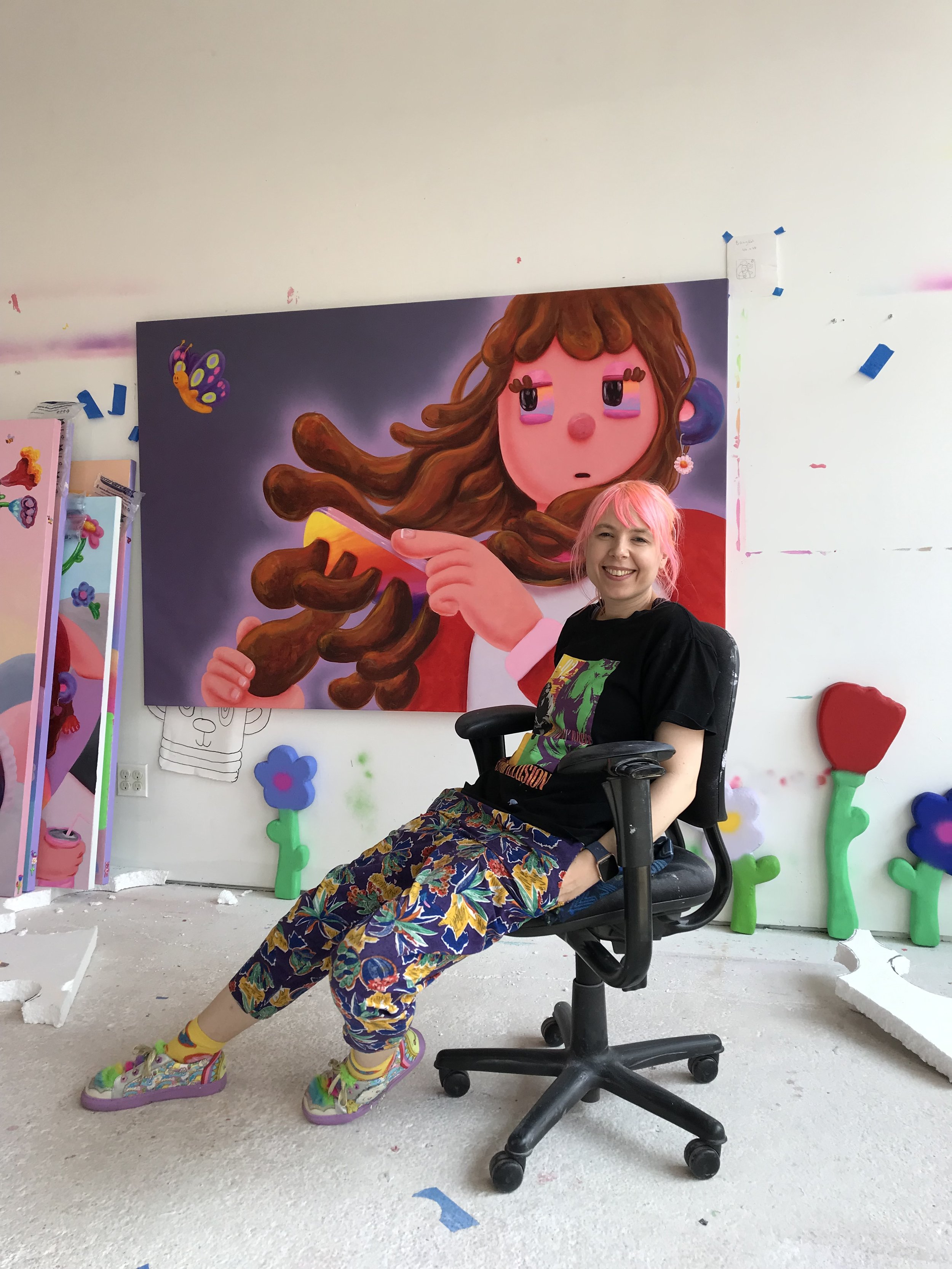Exploring Color, Fantasy, and Identity: An Interview with Super Future Kid
Super Future Kid, born in 1981 in East Germany, infuses her vibrant artworks with a kaleidoscopic blend of color and emotion that reflects her unique post-Berlin Wall upbringing. Delving deep into the realm of pop culture, her work is a playground of color-drenched characters caught in transient states of mind.
After her formal training at the KHB – Weißensee Academy of Art Berlin, where she graduated in 2008, Super Future Kid moved to Brooklyn, New York, to continue her artistic endeavors. Her international exhibitions span cities such as Amsterdam, Berlin, Los Angeles, and Miami, with notable solo shows in Copenhagen, Hong Kong, Los Angeles, New York, and Tokyo.
Super Future Kid's work is celebrated for its immersive quality. Her art serves as an avatar for self-exploration and a reflection on the human condition. Through expressive and playful landscapes, she invites viewers into a world where reality and fantasy intermingle, and the human figure becomes a canvas for identity and existential musings.
Artist Statement
Super Future Kid's work is a reflection of her ongoing quest for eternal childhood, while simultaneously contemplating the fragile nature of our physical being—a temporary vessel that, over time, succumbs to the inevitable cycles of breaking down and giving way to new existence.
The central figure, an avatar representing the artist's personal journey into self-awareness, is presented in a dynamic interplay of deconstruction, creation, and playfulness. This offers an elated view of life, encouraging viewers to engage with their own childlike senses of wonder and play, while also exploring the delicate transience of the human form and mind.
Super Future Kid captures the essence of existence as a sequence of eternal rebirth, where destruction paves the way for new life, echoing our emergence from the cosmic dust of expired stars.
How has your post-Berlin Wall upbringing influenced your vibrant and playful style?
The first 8 years of my life were spent in the socialist part of 1980s Germany. Life over there was pretty basic compared to West Germany, but I wasn’t aware of the difference and didn’t think that I was missing anything. In fact, I had a beautiful childhood. However, the sudden reunification with the West brought a sensory avalanche. The incredible influx of toys, objects, images, materials, and colors was mind-blowing—things we had never seen before. It was magical. This feeling has definitely left a great impression on me and shaped my affinity for colors and playfulness, which still finds its way into my work today.
Can you explain the significance of the central figure in your work and how it represents your personal journey?
All of my work is very personal, and even though the characters don’t visually resemble me, I still see them as alternate versions of myself. It helps me figure out who I am by placing myself into these characters and environments and exploring various ideas, feelings, and concepts.
How do you balance elements of pop culture with deeper existential themes in your art?
I suppose that the elements in my work could be interpreted as originating from pop culture, but nothing I paint is intended to represent a specific icon or concept. Instead, I like to use objects that come from my life—there is a personal connection and significance to me. These can be things I use in the studio, such as brushes, pencils, paints, drawings, but also ordinary objects like socks, flower vases, books, and things like that. Anything that orbits my life can find its way into my paintings. I’ve also always been a bit messy, and my childhood bedroom was littered with stuff strewn all over the floor. I still am like that, especially in my studio, which is why the “clutter” can also be found in my paintings. The mess is a part of me. So my work is more about immersion into a personal space, exploring one's own personality, and reflecting on what it means to be human.
What drew you to explore the concept of eternal childhood in your work?
A large part of me is still hardwired to my childhood self. I cannot leave it behind and never would want to either because it is who I am. I love to play—with ideas, colors, and materials. This is my way to keep discovering, learning, and growing as an artist and a person.
How do you use color to convey emotion and narrative within your playful landscapes?
Color is one of the most important things to me. I love any hue and shade—all colors are beautiful to me. They all have their own vibrations that trigger all kinds of feelings. I always have a “favorite” palette of hues that shifts with every body of work. One time I’m all about yellows and oranges; another time I’m more drawn to sea green, indigo, and purple. It never gets boring for me to choose colors when painting. Color and composition are where the energy comes from.
What do you hope viewers take away from the immersive quality of your art and the blend of reality and fantasy you create?
I always hope that my work triggers something positive. I love it when art transports you somewhere new or takes you back to places in your memories. Art that makes you daydream and feel good, gets you excited or inspired—that’s what it’s all about to me. That’s what I hope to achieve with my work as well.











